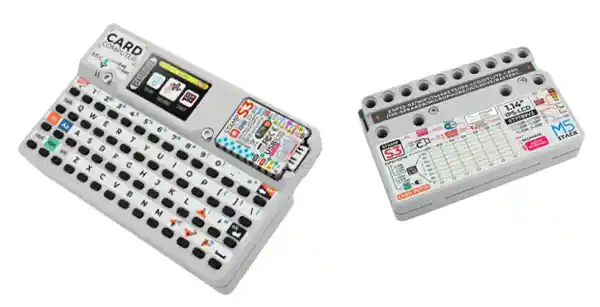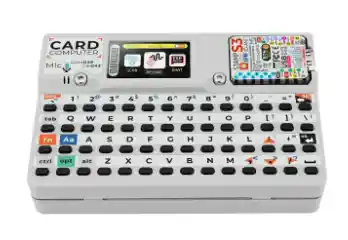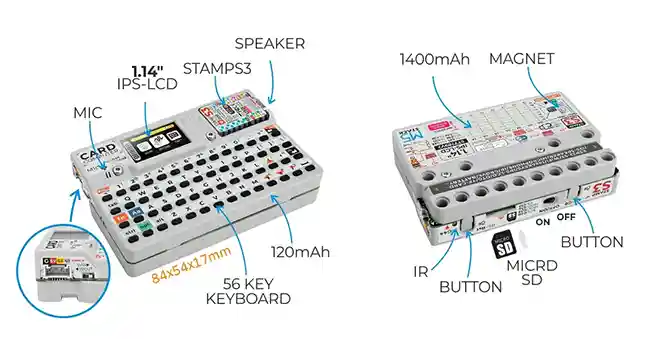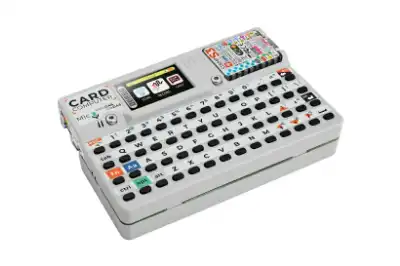The Cardputer is the new M5Stack device. With the ESP32-S3, TFT, keyboard, and barely the size of a card, this device aspires to be your pocket computer.
Of course, we cannot think of a “conventional” computer (with Linux or Windows). But the Cardputer is a highly portable, programmable device, loaded with features and extras.
The Cardputer is powered by the M5StampS3 development board, which is included in the product. This, in turn, includes an ESP32-S3 inside.
The decision to rely on the M5StampS3 seems to me to be a real success, as I mentioned a few days ago when I saw the M5Dial, since we can easily remove the M5StampS3, for example to exchange it between projects.

Regarding the ESP32-S3, an old acquaintance of the blog, it is the latest version of the popular Espressif processor and one of the most advanced and versatile System on a Chip (SoC) on the market.
This powerful SoC features a 240 MHz Xtensa® dual-core 32-bit processor, accompanied by 384 KB of ROM, 512 KB of SRAM, 8 MB of PSRAM, and 8 MB of Flash memory.
In addition, the ESP32-S3 provides the Cardputer with 802.11 b/g/n Wi-Fi connectivity and Bluetooth 5, making it perfect for wireless communication tasks.
Regarding the representative points of the Cardputer, obviously the first thing we find is its 56-key keyboard, arranged in 4 rows of 14 buttons. Despite its small size, the buttons are comfortable to use and emit a pleasant “click” when pressed.
The keyboard layout is English. So, Spanish-speaking friends, forget about our peculiar Ñ. It was to be expected in this type of device, but still we will miss it (oh my, what a joke).
At the top of the device, we find a 1.14-inch LCD screen with a resolution of 240x135 pixels, driven by the ST7789V controller. The same configuration is found, for example, in the popular M5Stick-C Plus.

As for audio, the Cardputer is equipped with a built-in SPH1423 microphone and a 1W speaker with an NS4148 amplifier. So we can both capture sound and generate our own sounds or notifications.
For data storage, the Cardputer includes a microSD card reader that allows you to expand the storage capacity to the needs of our project.
In addition, the Cardputer incorporates two lithium batteries. One of smaller size of 120 mAh, and another of 1400mAh in the bottom case. In Stand-By mode, the device consumes 0.26uA, so we should have autonomy for a long time.
As for connectivity, we only find a Groove connector, which we can use for I2C or UART. With this, we can connect additional sensors or peripherals to expand its capabilities.
In addition, we have an infrared LED for remote control applications, and a power button.
Here is a summary of the characteristics.
- SoC: Espressif Systems ESP32-S3FN8
- CPU: Xtensa® dual-core 32-bit LX7 microprocessor, @240 MHz
- 384 KB ROM, 512 KB SRAM, 8MB PSRAM, 8 MB Flash
- Included M5StampS3
- 1.14” 240x135 TFT display driver ST7789V
- 56-key keyboard (4 x 14)
- MEMS microphone, 1W speaker
- Micro-SD card
- Infrared LED
- Expansion via Groove port
- 120mAh + 1400mAh battery
- Dimensions 85x54x71mm
One of the distinctive features of M5Stack is to stand out for the quality of its cases. In this case, it does not disappoint, and we find a robust and compact plastic enclosure, joined with screws.
It also includes magnets to facilitate mounting and fixing on various surfaces. We also find a striking row of holes, designed to be compatible with Lego. Which seems to me a very intelligent and endearing detail.
All this in an impressive and reduced size of only 85x54x71mm. That is, a small wonder of engineering. I find it amazing how M5Stack manages to create devices with this set of technical characteristics in a small space.

In general, I can say that the Cardputer lives up to the expectation of being a “computer in the pocket”. It is an All-in-One multipurpose device with an ESP32-S3, keyboard, and screen, as well as IR LED, MicroSD, microphone, and speaker.
Whether for IoT projects, smart control, simply to enjoy technology, or just for fun, the Cardputer presents itself as a sweet candy for electronics enthusiasts.
References:
